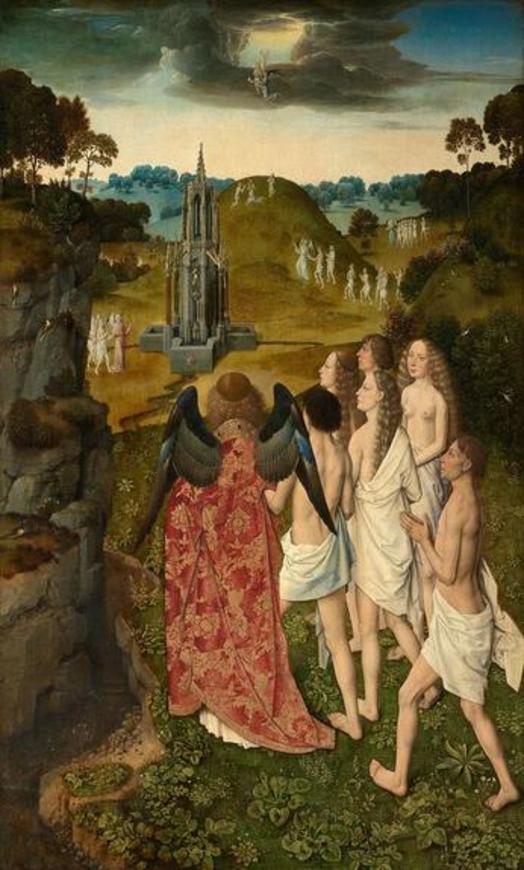This book, "Saint Patrick's Purgatory", recounts the journey of Owein, a knight who sought to repent for his sins. He enters purgatory, the space in which Christian souls are purified after death. He then passes through Hell and Heaven on Earth. It is these two places that inspired Dirk Bouts' works.
Here, we find ourselves in Heaven! The text describes it as a verdant place, bathed in light, within which a mountain offers access to the gates of celestial Heaven, symbolised by an opening in the clouds. Only Christians who have led a just and honest life – the elect – can access it.
In the foreground, an angel leads a group of the elect, dressed in a simple white cloth, towards a fountain into which four watercourses flow, alluding to the four rivers of Heaven described in the Bible. In the background, other chosen ones head towards a hill. At its peak, praying characters help two of their companions to ascend into the clouds.
The painter has skilfully arranged each member of the main group to give the viewer the feeling of being included in the composition. As a result, viewers can imagine themselves in the place of the knight as he discovers Heaven!
The colours of the landscape evolve from green to brown, then blue, fading into the distance. This atmospheric perspective, typical of Flemish painting, gives the image depth and invites the viewer's gaze to rise towards the sky, just like the elect!
Detail 1:
The painter's virtuosity is fully expressed in the representation of the angel: the plumage of his wings, the locks of his hair, the gold decoration on the cloak's collar and the moiré effects of the textile are represented with a sense of observation and detail, typical of Flemish painting.
Detail 2:
The plants and animals are faithful reproductions of existing species: each detail presents the beauty of divine creation. This precision in the rendering of plant species evokes the art of the Van Eyck brothers, in particular the famous Adoration of the Mystic Lamb altarpiece presented in Ghent (Belgium, Detail 3).

This book, "Saint Patrick's Purgatory", recounts the journey of Owein, a knight who sought to repent for his sins. He enters purgatory, the space in which Christian souls are purified after death. He then passes through Hell and Heaven on Earth. It is these two places that inspired Dirk Bouts' works.
Here, we find ourselves in Heaven! The text describes it as a verdant place, bathed in light, within which a mountain offers access to the gates of celestial Heaven, symbolised by an opening in the clouds. Only Christians who have led a just and honest life – the elect – can access it.
In the foreground, an angel leads a group of the elect, dressed in a simple white cloth, towards a fountain into which four watercourses flow, alluding to the four rivers of Heaven described in the Bible. In the background, other chosen ones head towards a hill. At its peak, praying characters help two of their companions to ascend into the clouds.
The painter has skilfully arranged each member of the main group to give the viewer the feeling of being included in the composition. As a result, viewers can imagine themselves in the place of the knight as he discovers Heaven!
The colours of the landscape evolve from green to brown, then blue, fading into the distance. This atmospheric perspective, typical of Flemish painting, gives the image depth and invites the viewer's gaze to rise towards the sky, just like the elect!
Detail 1:
The painter's virtuosity is fully expressed in the representation of the angel: the plumage of his wings, the locks of his hair, the gold decoration on the cloak's collar and the moiré effects of the textile are represented with a sense of observation and detail, typical of Flemish painting.
Detail 2:
The plants and animals are faithful reproductions of existing species: each detail presents the beauty of divine creation. This precision in the rendering of plant species evokes the art of the Van Eyck brothers, in particular the famous Adoration of the Mystic Lamb altarpiece presented in Ghent (Belgium, Detail 3).